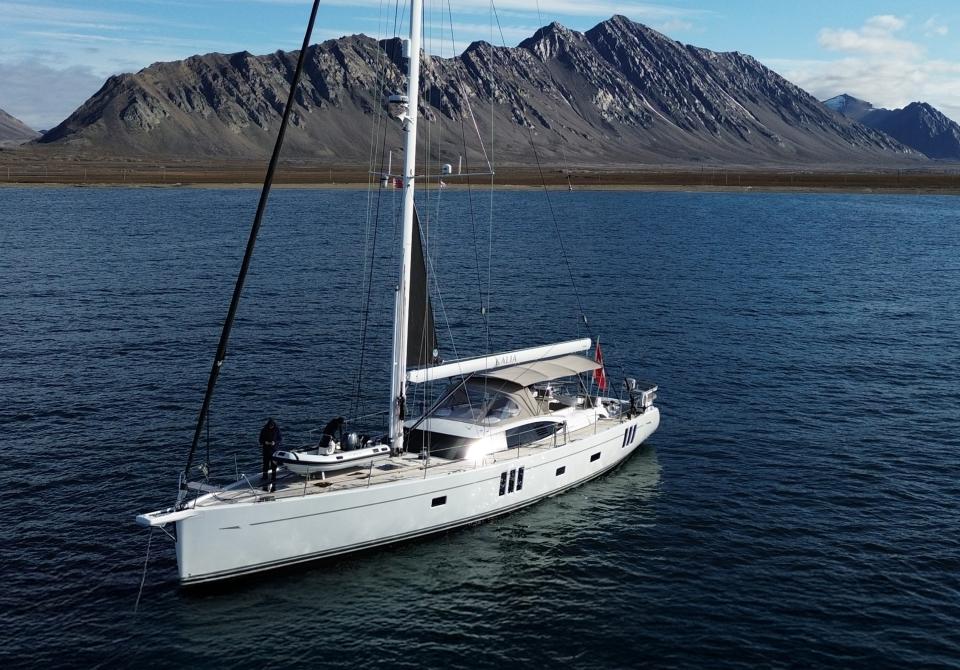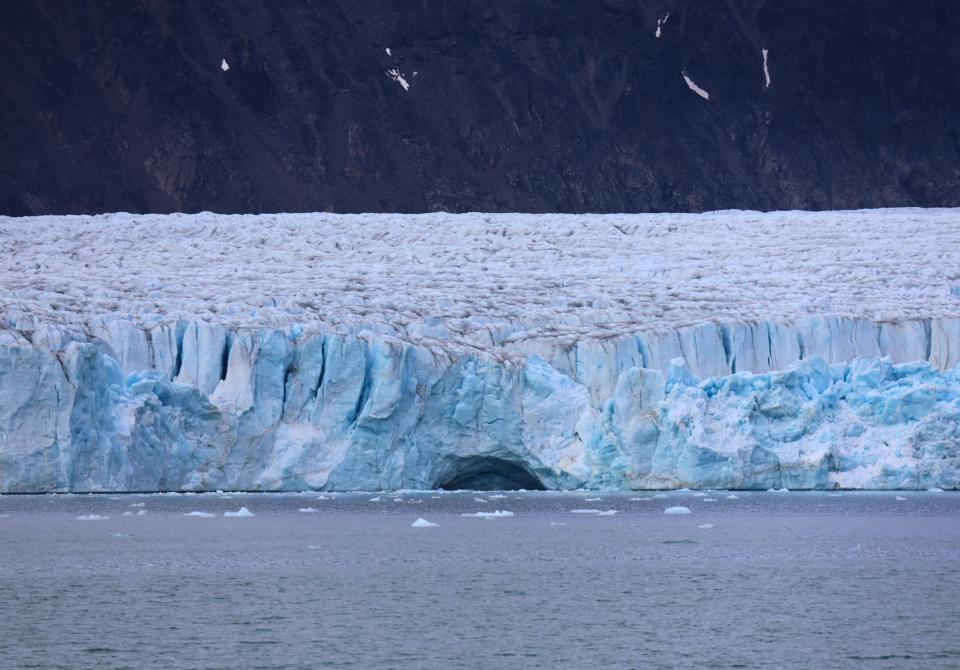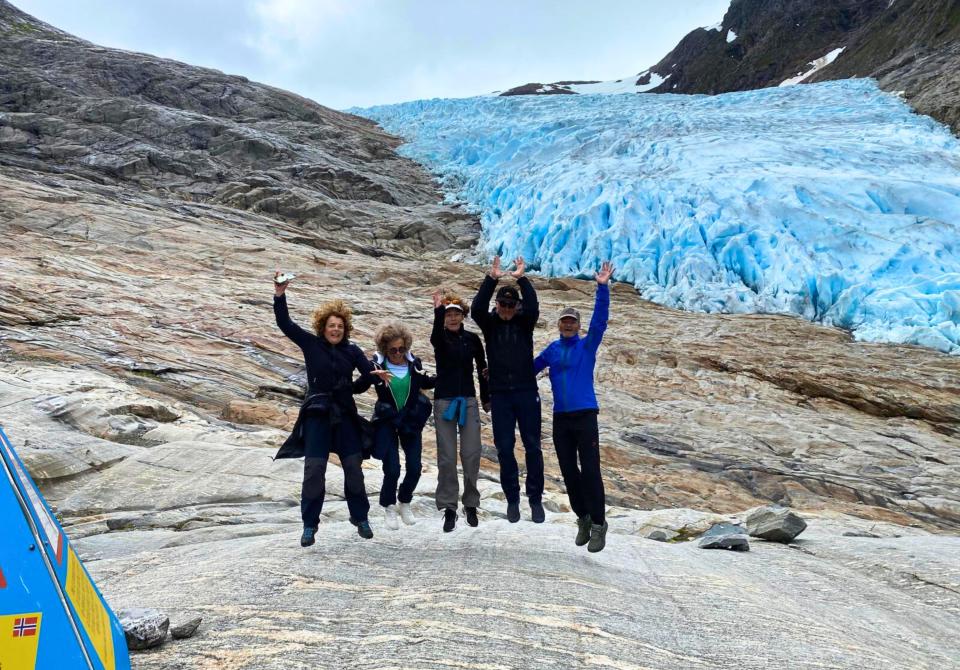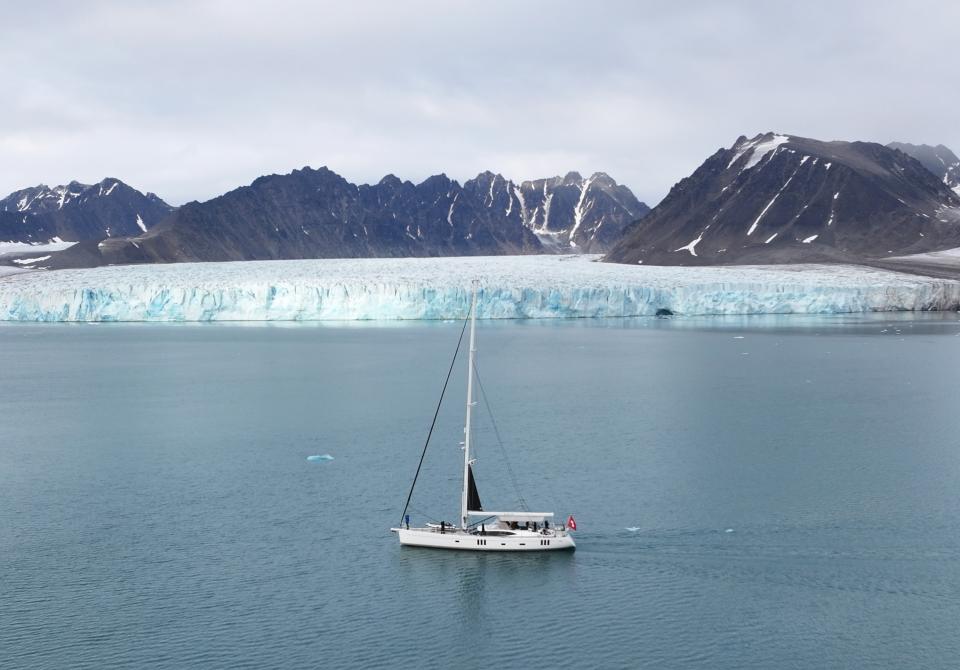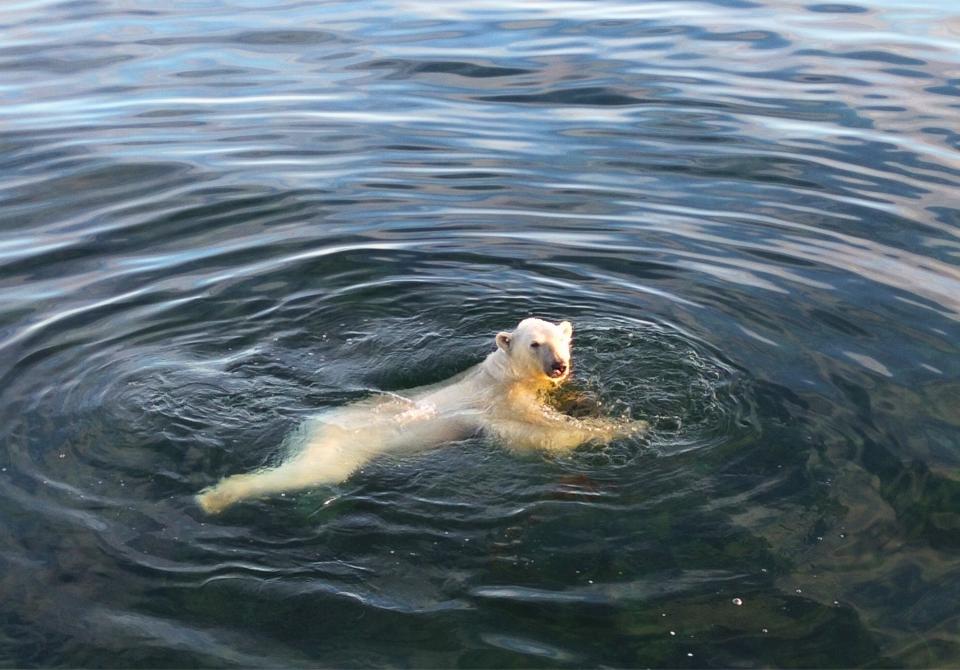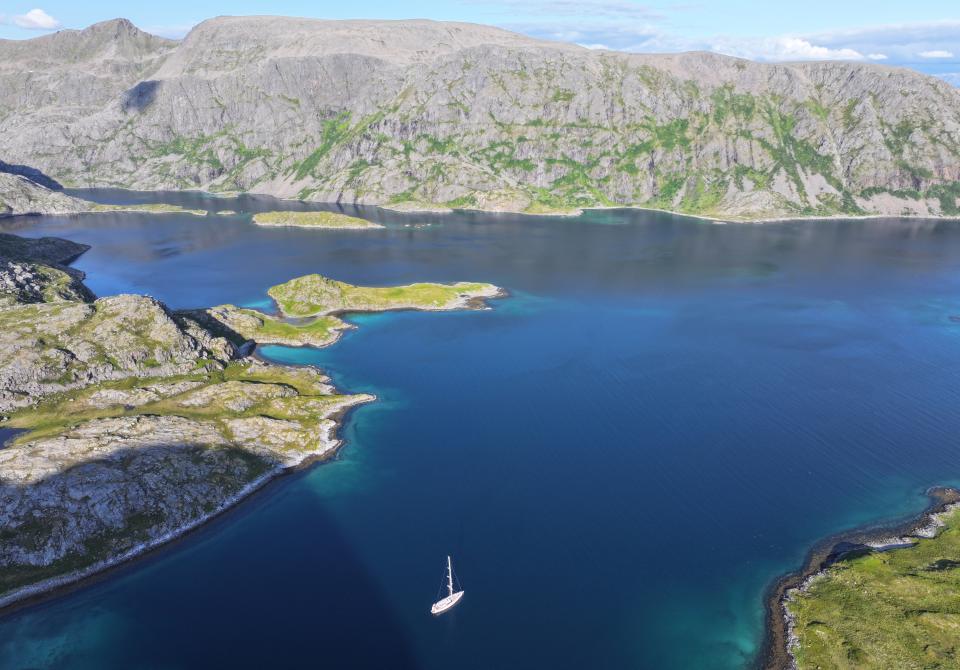Welcome to Svalbard in Arctic Norway, the high point of Christian and Katja Casal’s summer expedition on board their stunning 75-foot Oyster sailing yacht Kalia. This extraordinary voyage, which took them from the heart of the Mediterranean to the cool, pristine environment of 80°N, covered almost 9,000 nautical miles in one season, and introduced the Casals and their friends to some of the most unspoilt areas of the world.
After two years of extensive preparation, owners of Oyster 745 Kalia, Christian and Katja Casal embarked on an extraordinary journey to the far north, experiencing breathtaking landscapes and unique wildlife in the Arctic Circle.
The trip was two years in the making, with extensive planning for all involved. Understanding which destinations were best to visit, what equipment, permits and medical supplies would be needed, and forming the perfect itinerary that allowed for multiple crew changes, required an exacting plan.
Nothing was changed on Kalia ahead of the trip, but in the lead-up to their adventure, the Casals and their crew took great care to ensure their boat was up to the task. “We did extensive tests on every single component… on the engine, generator, watermaker and heating system,” explained Christian.
“You do read that watermakers don’t work well up north because the water is so cold and is less salty, but that was not an issue,” he said.
An undertaking of this size means your boat must be in tip-top shape, with reserves built in during the planning stages to ensure safety and security in the remotest destinations. “It [the boat] has to be in even better shape than for an Atlantic crossing, because where you’re going is really remote,” Christian said. “You will not meet many other boats, so if something goes wrong, you’re really alone, especially in Svalbard.”
Destination planning was also essential when forming their itinerary. As Norway does not have a formal marina industry, it took some time to gather information on each harbour en route to Svalbard, as well as checking fuel availability. “It’s not so easy to find it [fuel] in the books, and there isn't a website where you can book into a fully automated marina system like in the Med,” Christian said, but with enough research under their belt, they were ready to set sail on their Arctic exploration.
Kalia’s pre-adventure leg began with a delivery from Palma de Mallorca to Bergen at the start of the Norwegian summer, where boat engineer Marcello completed the preparations to allow them to be self-sufficient in the most remote areas of their journey. As July approached, the Casals and their first crew stepped back onto the boat, ready to cast off their lines and sail north to the Sognefjord, a deep, sinuous inlet of 115 miles that’s overshadowed by mountains reaching 1,800m, with equally deep, dark and clear water beneath the surface.
“We did roughly 100 miles under motor since there was practically no wind, but we had beautiful weather and consequently a great view of the mountains, glaciers and numerous waterfalls,” Christian said, as they approached Fjaerlandsfjord, where they spent the night surrounded by glaciers and a forest that sprawled down to the water’s edge, peppered with idyllic wooden houses.
From the mouth of Sognefjord, Norway’s longest and deepest fjord, Kalia’s crew looked northwards again to cruise between the islands. Forking off to the Holandsfjorden, the crew came ashore to hike and cycle some of the picturesque mountain trails, up to a viewpoint to take in the landscape.
“At the top, we were overwhelmed by the sight – the tongue of the glacier, deep blue, completely rugged and embedded in the granite rock that rises here. At 370km2, it’s the second largest glacier in Europe… the meltwater nourishes a lake which glowed green far below us. Behind it was the sea, and Kalia [moored] at the pier.”
Onwards to Bodø, Kalia crossed the Arctic Circle and after a crew change and time to re-provision, they sailed into good winds, sunshine and flat water in search of the famous and spectacular Lofoten archipelago. They took harbour at a fishery in Svolvær. Reflecting on the unusual dockage, Christian said, "Most times we just went into a harbour, and looked for a good pier for fishing boats, parked our boat there and then paid the fishing company €50 and they were happy. The people are super nice, so we never had any problems."
The Lofoten Islands are an established tourism destination, with popular highlights including the world’s most northerly golf course. Ranked #44 in Golf Digest’s top 100 courses, uniquely it can be played 24 hours a day in the Norwegian summer due to ‘the long day’, where the sun remains visible throughout the whole day in the summer months. It begged to be played by the crew.
After enjoying quiet and protected fjord anchorages, strenuous hiking and offshore whale watching, the crew headed towards Tromsø. "North of Lofoten, there are many individual, great spots to anchor where we were completely alone in places that looked like lakes," commented Christian.
A highlight for the crew was Meltefjorden, described as “the most beautiful anchorage” they’d ever seen. With many fjords to explore and small villages dotting the shoreline, they hiked through thick springy moss, blueberry bushes, grasses, heather and the cloudberry bushes that are only found in sub-polar areas, to a high vantage point, and “at the top, we crossed granite rocks, higher and higher, until we could see Kalia far away in front of us on a knoll, framed by mountains and the smaller fjords behind.”
The city of Hammerfest is over 1,300 nautical sailing miles from Bergen, a season’s worth of nautical miles in itself, but it’s where the crossing of the Barents Sea begins. The city serves as a gateway to the rugged and remote Svalbard archipelago, the reward for a testing crossing that had long been an ambition of Christian’s to complete.
Fascinated by the wild landscape and pristine environment, cruising Svalbard’s polar islands on his yacht had become a bucket list item after visiting the area by air five times in the last 20 years. By sailing here, he aimed to explore much further afield from Longyearbyen, reaching into areas that few people are able to see.
Kalia had encountered occasional rough seas on the passage north, storms not requiring much consideration in the summer as most of Norway’s coast can be negotiated within the shelter of islands and fjords. In the Arctic Circle, however, the sailing became more serious. Crossing the open ocean and dodging gales and wind-driven ice among the islands is a venture that required careful planning.
The crossing from Hammerfest to Spitsbergen began with a crosswind of 15 to 25 knots, accompanied by banks of rolling fog, described as “the first real sailing of this Norwegian adventure” by the crew. Just over two days later, she arrived at the southern tip of Svalbard.
Anchoring at Isfjord Radio, a World War II radio station at Isfjorden’s entrance, they were warned to stay on the boat because of a roaming polar bear ashore. “We immediately looked for him with the binoculars and, indeed, there he was,” Christian said. “Running across the plain in front of us and then along the mountain heading east. We couldn’t believe how fast he was going.”
“Suddenly we hear strange breathing noises and turn around to see two walruses looking at us, before performing a synchronised ballet, taking deep breaths and disappearing. While still following the sight of the bear, we see reindeer grazing in the foreground, and a little later, the back of a whale breaching out of the sea. Unbelievable!”
A local guide joined the crew on board in Longyearbyen, bringing an inexhaustible amount of knowledge about everything from the animal and plant world to geology, history, politics, glaciology and more. Kalia continued to the Billefjord where they found themselves surrounded by 80-100 beluga whales and breaching humpback whales, too.
At the nearby Nordenskiøld Glacier, the yacht became surrounded by small pieces of ice for the first time. Although it caused no concern, danger lay only metres away as a second large polar bear lounged nearby, raising his head to the yacht before lying back down again, thankfully too tired to investigate further.
Over the next weeks, Kalia’s crew visited glaciers, an old refuge where seal hunters once sought shelter, met local fishermen, and threaded gingerly through the ice floes in the Bay of Ny-Alesund. Having finally reached their latitudinal high point of the adventure at 80°N, the crew undertook a special baptism – a plunge into the freezing polar waters, followed by a celebratory Aquavit to warm their bones.
At the famous Monaco glacier, Kalia gradually encountered more ice, often small chunks, but also an increasing number of growlers measuring several metres in size and several tonnes in weight. “With a lot of slalom manoeuvring and pushing ice away (we had bought two extra-long poles with metal bolts at the end in Bodø, for this purpose), we pushed on further at first,” Christian said. “Over time, however, the ice that had broken off the glacier became so dense that we had to turn back.”
“It was frustrating, but at least we learned how a ship should be manoeuvred in ice – and we were able to catch a couple of medium-sized ice blocks to use in our drinks”, a nice touch for their cockpit sundowners.
Sailing in the ice was completely new to Christian. “Being close to a glacier and carving a path through the growlers was a very cool experience,” he said. “Sometimes it can feel almost absurd, like you’re in a lake in the Alps or Patagonia, with these big mountains coming directly out of the ocean.”
At the end of August, Katja and the Svalbard crew left the boat. It was nearing the end of the Arctic summer and the time had come to head south, returning to the Mediterranean. Christian, Marcello and their crew endured a rough crossing of the Barents Sea and continued 1,100 miles over five days to reach the southwest tip of Norway, stopping for only 20 minutes in Måløy to refuel before pushing onwards through the North Sea to the Strait of Dover.
As they progressed southwards, leaving the cold, rough seas behind them, temperatures began to rise again. Strong winds against currents in the English Channel made the stretch rough and difficult, but after stops in Brixham, UK, and Brest, France, they were treated to a smooth crossing of the Bay of Biscay.
After 8,932 miles, Kalia arrived safely back in Palma. In one long passage, her crew had journeyed through all seasons and weathers. “Sailing slowly, but surely, gaining one mile at a time allows you to fully enjoy the gradual change,” engineer Marcello wrote. “The landscape transforms, the climate changes, the colour of the sea, the sky and the land transform too”. With memories of growlers and polar bears fondly gained, the heat of the Mediterranean began to feel normal once more.
For Christian and Katja, the experience of Norway and Svalbard was unique, not only because of the sights outside, but also for the intimate way they shared this isolated place with like-minded friends.
Returning to a cosy saloon and a good dinner after a cold but exhilarating trip ashore was a standout memory for them. “We would have eight or nine people around the table enjoying basic but good food, and the atmosphere was like a skiing hut,” Christian said. “You are in such an interesting environment, and your interactions with friends are much deeper than they would normally be. We thought it was fantastic.”
Kalia’s trip to the Arctic and back was a huge undertaking, equating to three Atlantic crossings back-to-back. Reflecting on their season-long exploration, Christian said, “What you can see is phenomenal. I would argue that you need two months, otherwise it’s not worth it.”
Sailing in the far north is excellent, but much of the passage making in fjords and through leads will be done under engine, as sailing in a narrow fjord is often simply not possible. “Good winds hardly last the length of the fjord, and the currents, triggered by the 1.5 to 2m tide, should not be underestimated.”
Shore-based excursions were equally as good as the sailing, in their eyes. “We went on hikes and were fascinated by the nature and animal experiences. The country is simply beautiful, and the atmosphere is always magical, even in the fog,” Christian said.
“However,” he adds, “it would be dishonest of me if the less motivating moments were not addressed. Changing of the guard at 0240, getting up from your bunk in 9°C, sailing through a strong thunderstorm, crossing the choppy Barents Sea with cross seas (twice!), crossing the English Channel in headwind, the shopping, laundry and cleaning of the boat at weekends are all tough.”
Yet, upon reflection, Christian said, “These moments are far outweighed by the nature of the experience, the arctic safari, the great atmosphere on board and the many interesting conversations we had with a wide variety of friends.”
It’s worth getting out of your comfort zone every now and then so that you can enjoy life on a completely different level.
“I would recommend taking a year, at least, to plan this trip. Take your time, talk to all of your friends and talk to other skippers” Christian advises.
Before their trip, the Casals subscribed to Medical Support Offshore, as recommended by Oyster. With professional advice, they gathered a comprehensive kit of prescribed medications and additional medicines ahead of their trip.
While the air temperatures in summer can be warm, Arctic wind chill often makes it cold at sea, so the Casals recommend stocking up on base layers as for skiing. They purchased cold water dive suits in case of a propeller problem in freezing water, and bought 100m lines for tying ashore, with three strong ice screws for securing to snow or ice, but didn’t need to use them during the trip.
Yachting tourism, if any, “is practised very pragmatically," he says. "Spaces are not reserved; you just park the boat at a suitable pier and wait and see if there are any problems. Payment is made via the GoMarina app as there are hardly any harbour masters”. Charting details and the surroundings also begin to disappear and become inaccurate above 78-79°N, “Just be super careful and always check on forward-looking sonar”, he advises.
Finally, Christian looks back fondly on his entire trip. From planning through to finishing, he said, “It’s worth getting out of your comfort zone every now and then so that you can enjoy life on a completely different level.”
